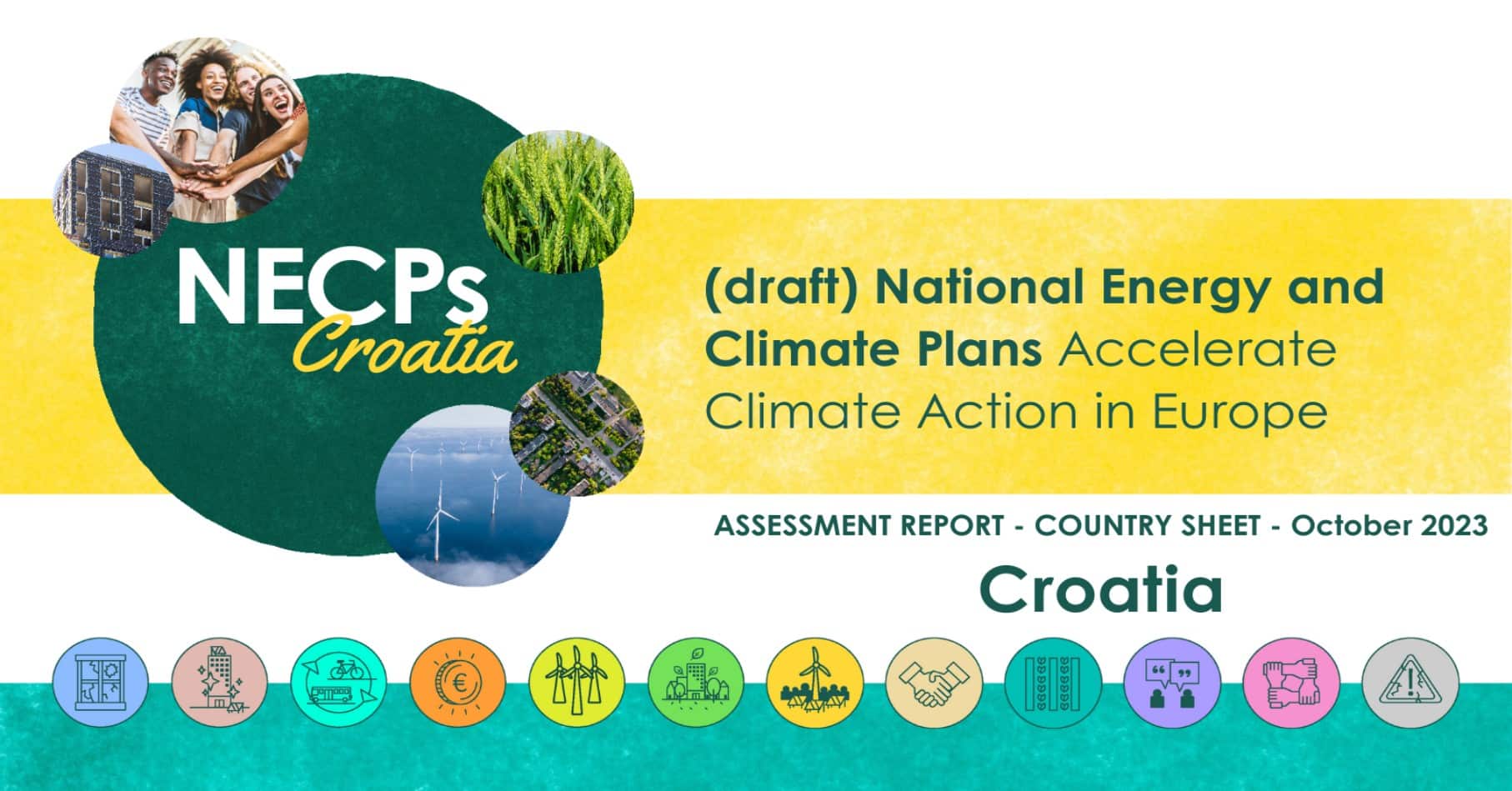Croatia submitted its draft National and Climate Plan (NECP) update on time. This assessment is based on the draft available on the Commission’s website. Croatia overall does not move towards a 1.5°C trajectory. Croatia however fulfils the minimum EU requirements for climate effort sharing and likely for renewable energy. The energy efficiency contribution is not ambitious enough to align with the EU 2030 energy efficiency target. Only some policies and measures (PAMs) are laid out in detail and linked to targets, while many still remain too vague and lack credibility. On top, Croatia plans to expand fossil fuels infrastructure while they should be phased out. Communication across governance levels and with stakeholders has improved significantly compared to the 2019 NECP.
RECOMMENDATIONS
- Define and set an economy–wide national climate target for 2030 as well as additional sectoral climate targets;
- Clearly identify financing needs and funding sources to implement some key measures, such as energy poverty alleviation;
- Ensure all PAMs are described in detail, including on description of activities, impacts on decrease of greenhouse gas emissions and means of monitoring.
Climate Ambition
The draft update mainly refers to the 2030 target for non-Emissions Trading System (non-ETS) sectors set under the Effort Sharing Regulation (ESR) (-16.7% compared to 2005 levels). The scenarios available in the draft show that Croatia does not fulfil its 2030 target for non-ETS sectors with existing measures (leading to a reduction of -6.7%), but it does with additional measures (-17.1%). It is worth noting that a significant discrepancy exists between the historical emissions data used for the scenario and those of the EEA. If EEA data were used for the 2005 baseline, Croatia would fail to meet their respective targets. This discrepancy should be clarified before the final NECP update. In any case, the scenario remains unambitious: Croatia should plan to significantly surpass its ESR target.
Unfortunately, the draft does not pay enough attention to longer-term pathways. It does not make commitments towards the EU-wide climate neutrality goal by 2050, and it is not sufficiently harmonised with the Croatian Low-Carbon Development Strategy (OG No. 63/2001), which focuses on emission reduction by 2030 with an outlook to 2050.
Regarding climate PAMs, the assessment ranges between comprehensive and credible to only sketched (e.g. MS-13, elimination of fossil fuels subsidies). All PAMs must be carefully detailed, to ensure they are effectively implemented and to make sure that Croatia achieves its ESR 2030 target.
Energy Transition
In its draft update, Croatia sets a renewable energy contribution of 42.5% in 2030, which might be the bare minimum to be in line with the European Commission’s benchmark to reach the binding EU 2030 renewable energy share of 42.5%. Among the PAMs for renewable energy, Croatia presented an important additional measure (OIE-7) intended to encourage energy sharing and the establishment of energy communities, starting from awareness-raising and improvements in the legislation.
The level of energy consumption foreseen in the draft plan for 2030 amounts to 8.14 Mtoe for primary energy and 6.55 Mtoe for final energy. This is not in line with the requirements of the 2023 Energy Efficiency Directive (EED) and with the 2030 EU energy efficiency target and only slightly lower than today for final energy. The gap towards the required contribution as per formula benchmark in the 2023 Energy Efficiency Directive (EED) is 1.31 Mtoe for primary energy and 0.68 Mtoe for final energy. Croatia is also not compliant with the 2.5% formula deviation for final energy, with a gap of 0.54 Mtoe compared to the required level. A global list of energy efficiency measures underpin the target, but not all measures are credible and well-functioning. Within the measure to renovate family houses (ENU-4) an energy renovation programme is predicted to be approved in 2023, however there is no information from the ministry that this is being developed. The National Energy Efficiency Portal is not functioning well, with latest data from 2018.
FOSSIL FUELS ALERT
- Coal – Croatia is late on quitting coal. The exit date is only in 2040, and phaseout only starts in 2030, with coal plant capacities remaining untouched before that date.
- Fossil gas – Fossil gas expansion must be halted. The draft foresees an increase in gas power plants capacity from 840MW in 2021 to 2231MW in 2050. It also includes measures to expand infrastructures (notably fossil gas storage and LNG/CNG) and to increase the energy efficiency of fossil gas.
IS MONEY WHERE THE MOUTH IS?
- Partially. Investment needs are covered, but the methodology used to calculate them is unclear. Several PAMs include potential funding sources, but they are only briefly detailed.
SNEAKY SUBSIDIES
- Fossil fuel subsidies are only very marginally addressed, and there is no plan for their phaseout. A measure (MS-13) is planned to analyse the state of play and define a phaseout plan, but is too vague. It should be rewritten with clearer phaseout commitments and implementation frameworks.
PUBLIC PARTICIPATION
- The platform normally used for public consultations on laws and strategies was not used so far. The government provided the possibility to send inputs to the draft (via email), but with too tight a deadline.
- An official platform for multilevel dialogues is missing. However, satisfactory stakeholders dialogues were organised by the REGEA energy agency as part of the NECPlatform project; some sectoral workshops were also organised by the Ministry.
Download croatia country sheet NECP assessment report
Download FULL NECP assessment report
PREVIOUS
NEXT

